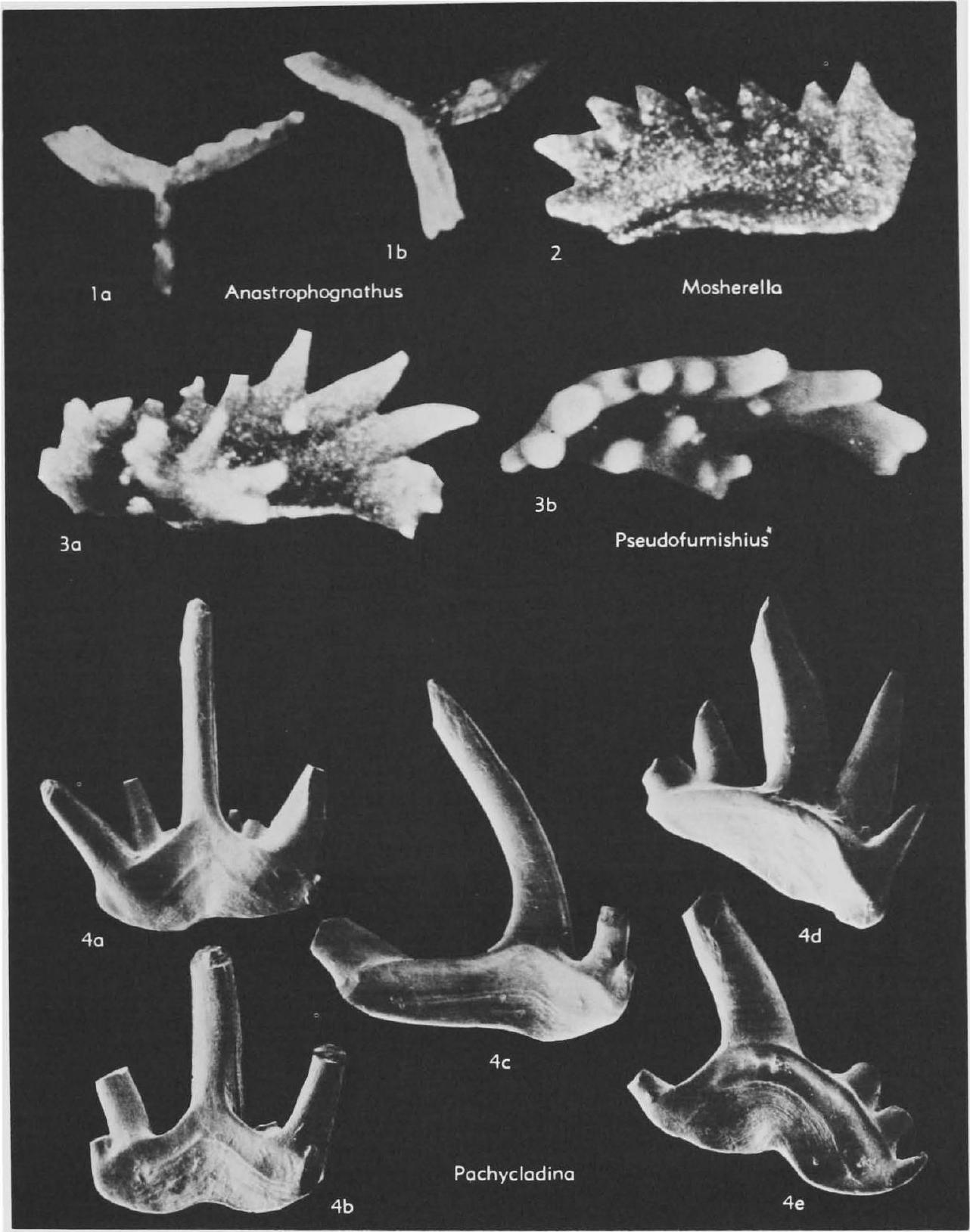Welcome to the Treatise on Invertebrate Paleontology!
Please enter a genera name to retrieve more information.

Pachycladina
Classification
Phylum:
Conodonta
Class:
Conodonta
Order:
Conodontophorida
Superfamily:
Gondolellacea
Family:
Ellisoniidae
Formal Genus Name and Reference:
Pachycladina STAESCHE, 1964, p. 277
Type Species:
*P. obliqua, OD
Images
(Click to enlarge in a new window)
FIG. 102,4. 0p. obliqua, Eu.(Italy); 4a, Sa dement, post. view; 4b, Sb element, post. view; 4c, Sc element, lat. view; 4d, Pa element, lal. view; 4e, M element, post. view; X42 (Sweet, n).
Synonyms
Geographic Distribution
Eu.-N.Am
Age Range
Beginning Stage in Treatise Usage:
L.Trias.
Beginning International Stage:
Induan
Fraction Up In Beginning Stage:
0
Beginning Date:
251.9
Ending Stage in Treatise Usage:
L.Trias.
Ending International Stage:
Olenekian
Fraction Up In Ending Stage:
100
Ending Date:
246.7
Description
Apparatus seximembrate: Pa carminate to palmate, with smooth-surfaced, laterally expanded midlateral ribs, Pb digyrate, with processes of subequal length curving faintly in opposite directions distally and tending to develop laterally expanded, platformlike midlateral ribs, M digyrate, with processes of unequal length, S a alate, with no posterior process, S b digyrate, bowed, a slightly asymmetric version of S a, Sc bipennate, with long posterior process and short, in-curved anterior process. Elements hyaline, with thick growth axes in all denticles. Lower surface of all elements cuneiform, with small basal pit and broadly expanded zones of recessive basal margin forming scarlike areas on inner and outer sides of Pa elements but only on inner sides of those in other positions. [The apparatus of Pachycladina is reminiscent of that of Parachirognathus, but appears to have been more differentiated, and the elements are more robust and have peglike rather than laterally compressed and fused denticles. These differences may prove to be of only specific significance and attributable to differences in geographic distribution. However, representatives of the two genera occur together in both North America and Europe, Parachirognathus dominating in the former and Pachycladina in the latter.]
References
Museum or Author Information
Classification
Phylum:
Conodonta
Class:
Conodonta
Order:
Conodontophorida
Superfamily:
Gondolellacea
Family:
Ellisoniidae
Formal Genus Name and Reference:
Pachycladina STAESCHE, 1964, p. 277
Type Species:
*P. obliqua, OD
Images
(Click to enlarge in a new window)
FIG. 102,4. 0p. obliqua, Eu.(Italy); 4a, Sa dement, post. view; 4b, Sb element, post. view; 4c, Sc element, lat. view; 4d, Pa element, lal. view; 4e, M element, post. view; X42 (Sweet, n).
Synonyms
Geographic Distribution
Eu.-N.Am
Age Range
Beginning Stage in Treatise Usage:
L.Trias.
Beginning International Stage:
Induan
Fraction Up In Beginning Stage:
0
Beginning Date:
251.9
Ending Stage in Treatise Usage:
L.Trias.
Ending International Stage:
Olenekian
Fraction Up In Ending Stage:
100
Ending Date:
246.7
Description
Apparatus seximembrate: Pa carminate to palmate, with smooth-surfaced, laterally expanded midlateral ribs, Pb digyrate, with processes of subequal length curving faintly in opposite directions distally and tending to develop laterally expanded, platformlike midlateral ribs, M digyrate, with processes of unequal length, S a alate, with no posterior process, S b digyrate, bowed, a slightly asymmetric version of S a, Sc bipennate, with long posterior process and short, in-curved anterior process. Elements hyaline, with thick growth axes in all denticles. Lower surface of all elements cuneiform, with small basal pit and broadly expanded zones of recessive basal margin forming scarlike areas on inner and outer sides of Pa elements but only on inner sides of those in other positions. [The apparatus of Pachycladina is reminiscent of that of Parachirognathus, but appears to have been more differentiated, and the elements are more robust and have peglike rather than laterally compressed and fused denticles. These differences may prove to be of only specific significance and attributable to differences in geographic distribution. However, representatives of the two genera occur together in both North America and Europe, Parachirognathus dominating in the former and Pachycladina in the latter.]
